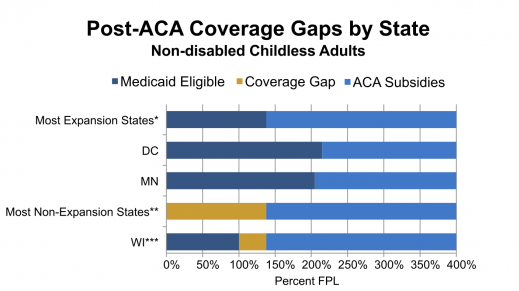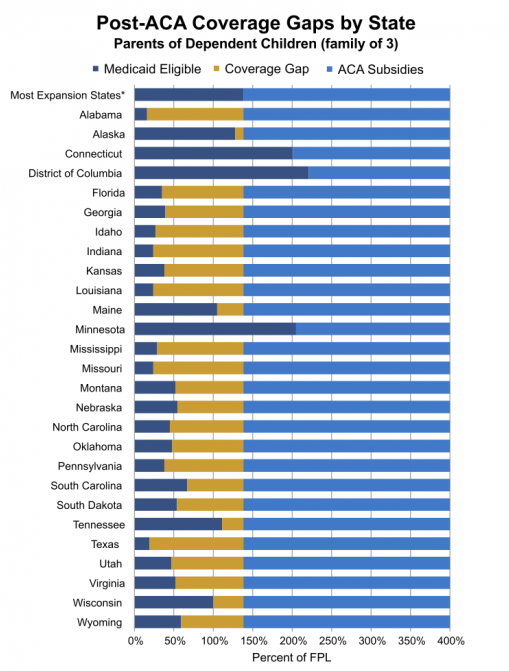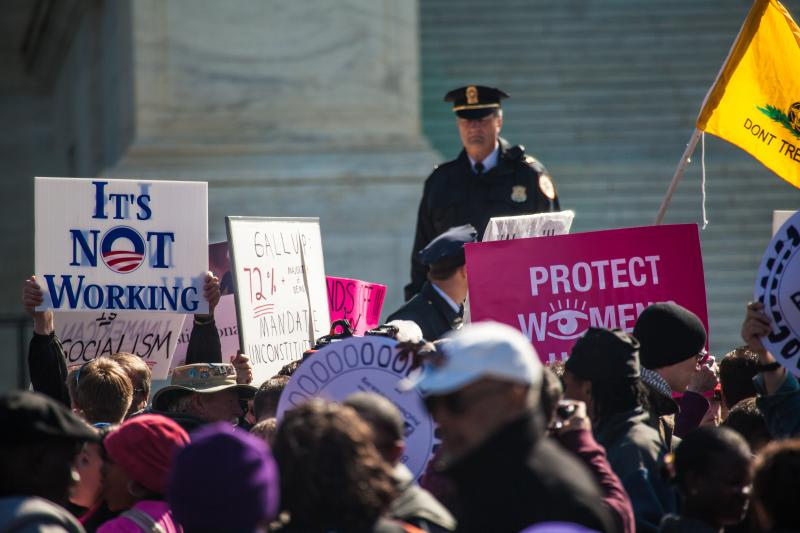By Manon Scales
One of the primary goals of the Affordable Care Act (ACA) is to expand the availability of health insurance coverage and decrease the number of uninsured individuals. This, the law will do – the Congressional Budget Office’s most recent projections for 2024 show an overall decrease of 26 million non-elderly uninsured from what that number would have been absent the ACA. However, despite the decrease, 31 million individuals are projected to remain uninsured. A subset of these individuals will fall into the “coverage gaps” created by the Supreme Court decision that made the expansion of state Medicaid programs optional.
States that elect to expand Medicaid under the ACA must adopt a minimum eligibility threshold of 138 percent of the federal poverty level (FPL) for pregnant women and adults with dependent children, and must also cover non-disabled childless adults up to that level (see figure 1).

(CT, DC, and MN are also expanding and have elected to increase the Medicaid eligibility threshold beyond that required by the ACA)
**AL, AK, FL, GA, ID, IN, KS, LA, ME, MS, MO, MT, NE, NH, OK, PA, SC, SD, TN, TX, UT, VA, WI, WY
***Wisconsin covered childless adults up to 100% FBL before the passage of the ACA
Data from Kaiser Family Foundation, “Where are States Today? Medicaid and CHIP Eligibility Levels for Children and Non-Disabled Adults as of April 1, 2014,” June 11, 2014. http://kff.org/medicaid/fact-sheet/where-are-states-today-medicaid-and-chip/
This 138 percent poverty threshold dovetails with the eligibility requirements for receiving subsidies to purchase coverage in the Health Insurance Marketplaces –people with incomes between 138 percent FPL and 400 percent FPL are eligible for the subsidies. Thus, in those states that elect to expand Medicaid, there is seamless eligibility for government support up to 400 percent of the FPL for both childless adults and adults with dependent children (figures 1 & 2).

(CT, DC, and MN are also expanding and have elected to increase the Medicaid eligibility threshold beyond that required by the ACA)
Data from Kaiser Family Foundation, “Where are States Today? Medicaid and CHIP Eligibility Levels for Children and Non-Disabled Adults as of April 1, 2014,” June 11, 2014. http://kff.org/medicaid/fact-sheet/where-are-states-today-medicaid-and-chip/
Connecticut, the District of Columbia, and Minnesota are expanding their Medicaid programs beyond the requirements of the ACA. Consequently, individuals who would otherwise be eligible for subsidies will instead be eligible for Medicaid in these regions.
By contrast, there are coverage gaps in states that have elected not to expand the program. Alabama and Texas, for example, have the lowest eligibility maximums (16 percent FPL and 19 percent FPL, respectively). This leaves a large gap between the maximum income for Medicaid eligibility and the minimum income necessary to qualify for Health Insurance Marketplace subsidies. The Kaiser Family Foundation estimates that 4.8 million adults nationwide will fall into the coverage gap in 2014, leaving them with no affordable health insurance options.
Universal access to affordable health insurance is a goal that transcends party lines. As it stands, the realization of this goal is in the hands of individual states. Whether they expand their Medicaid programs, rely on uncompensated emergency room care, or look for alternate ways to provide coverage, state will have to find solutions beyond the provisions of the ACA.
Manon Scales is an Associate Online Editor with GPPReview and is finishing her first year in the Master of Public Policy/Juris Doctor joint-degree program at Georgetown University. She received a B.A. in Political Science from the University of Massachusetts, Amherst in 2011. Manon has interned for the Alliance for Health Reform in Washington, DC and the Public Education & Business Coalition in her hometown of Denver, Colorado. She hopes to pursue further work in economic and social policy research and management.

Very soon this web site will be famous amid all blog
viewers, due to it’s nice articles or reviews